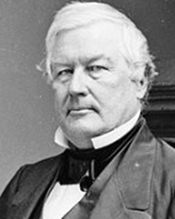The Presidents of the USA



| Born: | Jan. 7, 1800, Cayuga County, N.Y. |
| Political party | Whig |
| Education | six months of grade school; read law, 1822 |
| Military service | Union Continentals (Home Guard) , NY militia (Major) |
| Previous public office | ♦ New York State Assembly, 1829-33 ♦ U.S. House of Representatives, 1833-35, 1837-43 ♦ New York State comptroller, 1847-48 ♦ Vice President, 1849-50 |
| Died | Mar. 8, 1874, Buffalo, N.Y. |
Unlike most presidents, Fillmore knew poverty as a boy. Of old New England stock, he was born in western New York, where his father scraped out a living as a tenant farmer. In his youth he received only a limited education before being apprenticed as a clothier. His prospects brightened when he was offered the chance to read law with a local judge; after moving to Buffalo, he continued his legal training and in 1823 was admitted to the bar.
Fillmore began his career in national politics as an opponent of Andrew Jackson, joining the Whig Party during his first term in the House of Representatives in 1833 and becoming party congressional leader in 1841. He opposed the spoils system, under which government posts were filled according to the recommendations of party bosses, and was in favor of national funding for internal improvements. Two of the tariff bills he wrote as chair of the Ways and Means Committee were vetoed by President John Tyler, but a third was approved in 1842.
Fillmore lost the Whig nomination for Vice President in 1844 and was defeated in an election for New York governor that same year. In 1847 he was elected New York State's first comptroller.
Fillmore received the Vice Presidential nomination in 1848 to appease Northern Whigs opposed to the nomination of slaveholder Zachary Taylor. As Vice President, he presided fairly and firmly in the Senate over the intense debates between Northern abolitionists and Southern slaveholders.
After Taylor died suddenly on July 9, 1850, Fillmore became president. The change in leadership also signaled an abrupt political shift. Fillmore had very different views on the slavery issue.
When Fillmore became President, he broke his political alliance with New York State Whig party boss Thurlow Weed and appointed a completely new cabinet, including Daniel Webster as secretary of state. He reversed Taylor's opposition to Henry Clay's Compromise of 1850, a measure designed to effect a compromise over extension of slavery into the newly acquired territories. It admitted California to the Union as a free state, permitted slavery in the New Mexico and Utah territories, abolished slavery in the District of Columbia, and strengthened the fugitive slave law to allow Southern slaveholders to use Northern state courts and police in efforts to retrieve runaway slaves. Fillmore approved the compromise to avoid sectional conflict.
His major accomplishment in foreign policy was the decision to send a fleet commanded by Commodore Matthew C. Perry to Japan, which resulted in an 1854 treaty that opened up that nation to U.S. trade.
As a result of his sectional compromises, Fillmore was discredited among Northern Whigs, and after 53 ballots he lost the bid for his party's Presidential nomination in 1852 to General Winfield Scott, the third war hero the Whigs had nominated for the Presidency. But the party destroyed itself over the slavery issue, and Fillmore turned the White House over to Democrat Franklin Pierce; he then retired to Buffalo to practice law.
By 1856, Fillmore's Whig Party had ceased to exist, having fallen apart due to dissension over the slavery issue, and especially the Kansas-Nebraska Act of 1854. Fillmore refused to join the new Republican Party, where many former Whigs, including Abraham Lincoln, had found refuge. Instead, Fillmore joined the anti-immigrant, anti-Catholic American Party, the political organ of the Know-Nothing movement which nominated him for president in 1856. Hoping to transform the party into a national, conservative organization, Fillmore downplayed nativism in the campaign and emphasized the Union issue instead. His candidacy alienated both antislavery forces and fervent nativists, and he finished a distant third in the election. But after the election the party disappeared and he retired from politics.
Fillmore became active in local affairs in upstate New York. A man who had received only six months of schooling in his life, he had begun his political career in New York by developing the public school system. In later life he founded the University of Buffalo (becoming its first chancellor) and the Buffalo Fine Arts Academy.
He opposed Lincoln's election and his Civil War administration and supported Andrew Johnson's stand against radical Reconstruction measures, but he took no active part in the controversies over these issues.
Although honest and hardworking, Fillmore manifested a habitual lack of self-confidence that significantly limited his political effectiveness. He was a pompous, colorless individual who rose far beyond his ability, and as such he left only a limited mark on his generation.
His support of the Compromise of 1850 preserved the Union for another decade but destroyed his own political career.
He is consistently included in the bottom 10 of historical rankings of Presidents of the United States.